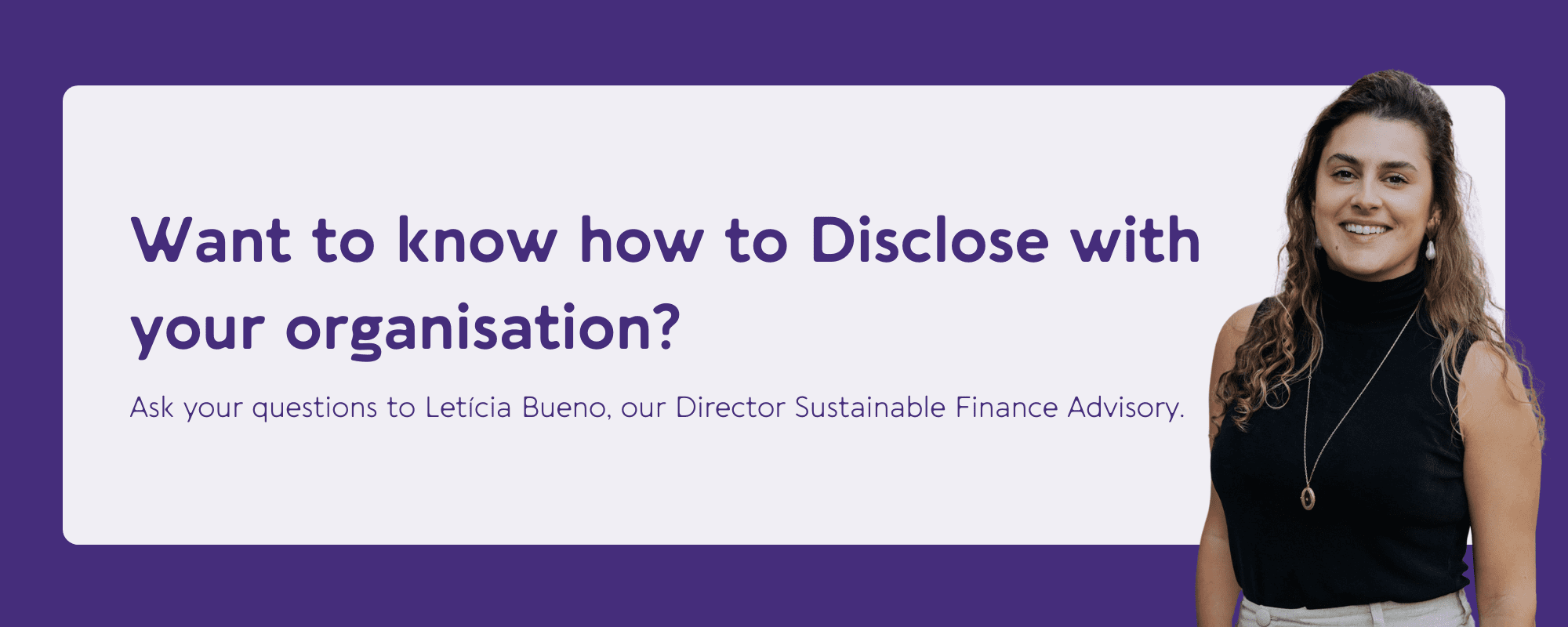Navigating SFDR Disclosure: 11 Practical steps for Compliance
Due to the Sustainable Finance Disclosure Regulation (SFDR), financial market players (FMPs) in Europe are obliged to report on their sustainability, whether it is a big part of their processes or not. However, complying with sustainability reporting may be a challenge due to the complexity of the disclosure regulation. That’s why we break it down into 11 practical steps: How to comply with SFDR?
By the way, read our blog ‘What is SFDR?’ first for a full definition, broader context and some tips regarding understanding the Sustainable Finance Disclosure Regulation.
Step 1: Understand Your Entity
First, it is important to understand that SFDR requires all FMPs to identify the sustainability risks linked to their entity and the negative sustainability impacts associated with their financial products. This applies even if the FMP does not have explicit sustainability goals or is not taking actions to address these risks and impacts. In such cases, FMPs are required to provide explanations for their (lack of) approach to these two aspects.
So, as a first step, recognise which of your financial products fall under the SFDR scope (which is: most of them) and determine the level of disclosure required for your product categories in the following steps.
Step 2: Review Investment Objectives
Second, assess the primary goals of your financial products. Are they non-sustainable in essence, do they mainly focus on promoting environmental or social characteristics, or are they a broader primary sustainable investment?
As you dive into your investment objectives, determine which ESG factors hold most significance to your product’s investment strategy. This could include a wide variety of aspects, such as carbon reduction, gender diversity, clean energy, social impact, employee wellbeing etc. You could consider key materiality topics in the focus sectors as a place to start.
Step 3: Define Key Performance Indicators and a Data Collection Strategy
Third, pick the most relevant metrics that will effectively measure the achievement of your selected Investment Objectives. For example, if your Investment Objective is to reduce waste, you may choose the KPI “tonnes of waste saved from going to landfill per year”.
Determine how you will collect this data from your portfolio companies and establish a method for ongoing monitoring. Microsoft Excel could be a good starting point, but as your portfolio grows and becomes more complex, it may be necessary to consider a data management software.

Step 4: Determine which SFDR Category your products fall in
Fourth, evaluate how your financial products align with the SFDR categories:
- Article 8: For products promoting environmental or social characteristics.
- Article 9: For products with a primary sustainable investment objective.
Article 9 products typically embody a stronger commitment to sustainability, while Article 8 products also incorporate ESG considerations but have more typical financial-oriented investment objectives.
Naturally, Article 9 products require more disclosure than Article 8 products.
Read more about the difference between Article 8 & 9 products and its implications in this blog.
Step 5: Document Your Categorisation
In the fifth step, maintain comprehensive documentation that explains the rationale for classifying each financial product as either Article 8 or Article 9. Elaborate on the frameworks and methods used to make these determinations (also see ‘What is SFDR?’). Explain how sustainability risks are identified, assessed, and managed.
This documentation is vital for adhering to regulatory requirements and internal audits, especially as regulations evolve and potentially shift. By having well-documented evidence that aligns with current guidelines, your methodologies will remain effective for the future.
Step 6: Familiarise yourself with the regulatory templates
According to the EU Commission, you are free to use any framework or methodology to conduct your own sustainability assessments in step 5. However, whilst there is freedom here, you should still familiarize yourself with the regulatory templates for product-level disclosures to ensure that, at a high-level, your disclosures align with the specified formats and data requirements. See them here.
Step 7: Independent Verification
Moving to the seventh step, consider the value of independent verification. Engaging an external entity to review and validate your sustainability disclosures adds a layer of credibility. This process enhances the reliability of your reported information, reinforcing transparency and trust with your stakeholders. Independent verification demonstrates your commitment to accuracy and reinforces your dedication to aligning with the SFDR objectives.

Step 8: Start disclosing
For step 8, initiate the disclosure process. Simply utilise your current communication channels, like your website or annual reports, to share this information. As your strategy matures, it’s a common approach to create a distinct sustainability report that delves deeper into the specifics.
Remember, clarity and transparency are paramount. The essence of this regulation is to foster informed choices and openness while deterring misleading claims. As a result, your disclosures should be readily available and prominently showcased, rather than tucked away in a lengthy and intricate policy document. This accessibility ensures that your audience can readily access and understand the disclosed information, aligning with the overarching goals of the SFDR.
Step 9: Ensure ongoing reporting
Make sure you implement ongoing reporting, rather than a one-off. Specify how often and where these reports will be made available. Consistency is key. This is also where a data-software could come in useful, with many providers offering the possibility to automatically generate a report based on the data input.
This regular reporting in itself will facilitate the continuous monitoring of your ESG impact, so you can see where things are going well, and also where you may need to revisit or make improvements to the procedures being followed or the data being collected. If any changes subsequently need to be made, this should be done in a clear and transparent way.
Step 10: Link Remuneration Policies to the Achievement of Objectives
In the tenth step, ensure that remuneration policies correlate with goal achievement. This encourages investment managers to focus on ESG goals. Usually, this means connecting pay to hitting ESG targets (carried interest). There is no one-size-fits-all method of implementing this carried interest – it depends on the fund, the structure, the mandate, and the conditions. Therefore it may require some creativity to devise the right structure.
Make sure to read more about sustainable Remuneration Policies here if you’re interested.
Step 11: Integrate Sustainability Factors into Investment Decisions
Step 11 is by far the most important one. You can do all this work to prepare the structure, disclosure and remuneration, but it is not going to make any difference if it is not actively implemented into decision-making and action.
Provide guidelines, criteria, and procedures to make it as easy as possible for investment managers to implement the new changes. This can take the form of an initial sustainability checklist when investment proposals are first considered, that comprise the basic minimum criteria to be met. It may also be a new ESG Committee, to oversee final investment decisions and challenge projects with the key KPIs in mind.
Conclusion
In conclusion, these 11 steps offer a clear path to SFDR compliance. Each step plays a vital role in aligning your financial practices with the regulations, ensuring transparency and advancing sustainable finance objectives.
Any questions?
At Sustainable Capital Group, we understand the complexities of EU regulations in sustainable finance, and our sector experts are here to assist you. For personalised guidance, simply fill out our contact form, and we’ll be in touch with you shortly.



